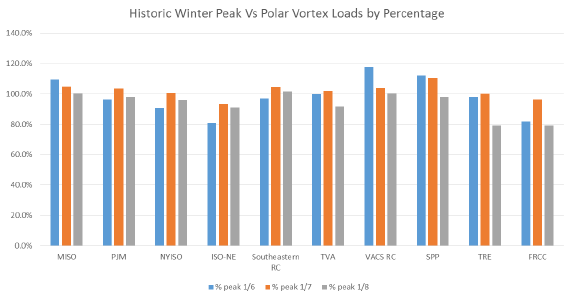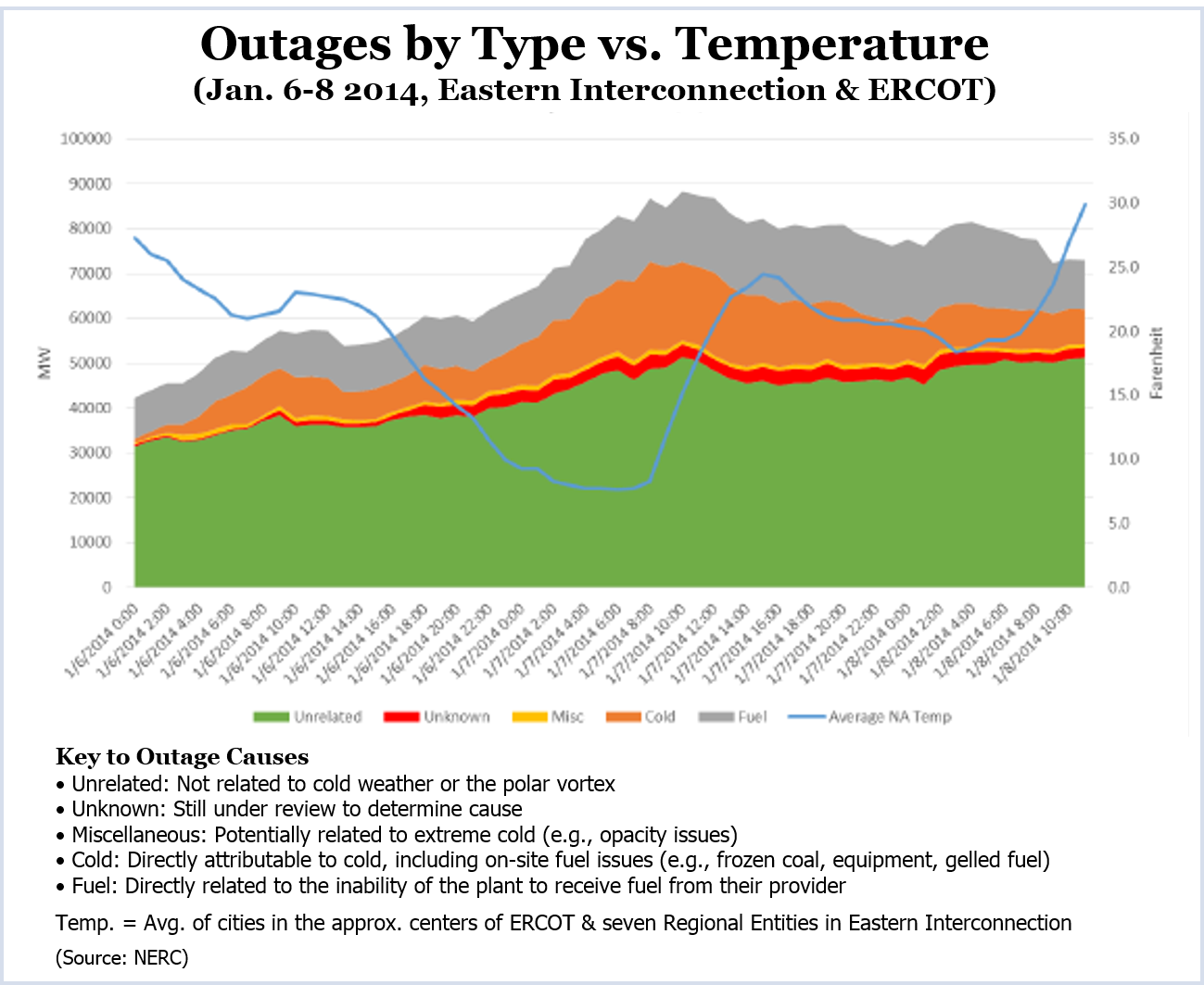Grid operators demonstrated resiliency during January’s polar vortex but more needs to be done to prepare for future cold spells, the North American Electric Reliability Corporation said in a report released today.

All-time Winter Peaks vs. Polar Vortex Loads by Pct. (Source: NERC)
NERC’s Polar Vortex Review noted that only one balancing authority shed load despite the fact that many areas in the Midwest, South Central and East Coast experienced temperatures 20 to 30 degrees below normal. (South Carolina Electric and Gas (SCE&G) dropped less than 300 MW, less than 0.1% of the total load for the Eastern and ERCOT Interconnections.)
Howard Gugel, NERC director of performance analysis, said the industry performed well “under extremely challenging circumstances. Industry owners and operators used all the resources at their disposal to keep the grid reliable.”
Grid operators relied on voltage reductions and demand side management to prevent load sheds. NERC said the performance validated its regular training and drills “as the operators and other [… entities were able to effectively and successfully implement emergency procedures.”
Record Cold
Forty-nine cities set new record lows, with Minneapolis shivering through 62 consecutive hours of temperatures below zero from Jan. 5 to Jan. 7. On Jan. 6, the average daily temperature in the U.S. was 17.9 F, the first time the average dropped below 18 F since 1997. The 17-year run of temperatures above 18 was the longest such span on record and occurred during a period in which an increasing portion of the generating fleet had become fueled by natural gas, NERC noted.
The cold pushed many generators beyond the temperature range for which they were designed.
Nevertheless, an analysis of NERC’s Generating Availability Data System (GADS) found that most generators units performed within the equivalent forced outage rate (EFOR) range expected based on the past five years. The exception was natural gas units, which had a higher-than-expected forced outage rate in January in two regions, the Midwest Reliability Organization and Southeast Reliability Corp.
Demand Records
Eight of 10 areas included in the study — all but ISO-NE and the Florida Reliability Coordinating Council (FRCC) — set all-time winter demand records on Jan. 6 or 7. The VACAR South reliability coordinator, which includes SCE&G, busted its record by almost 18%. (NERC’s review did not include the Western Electric Coordinating Council, which was largely unaffected by the polar vortex.)
Causes
Like PJM, other regions experienced fuel deliverability problems, natural gas pipeline outages and frozen equipment. The report catalogues dozens of cold-weather problems that led to outages, delayed starts or deratings, most of them involving the freezing of water and the gelling of oil and diesel fuel.

Among the recommendations:
Generators
- Review and update power plant weatherization programs, including procedures and staff training.
- Continue or consider implementing a program for winter preparation site reviews at generation facilities.
- Review the basis for reporting forced and planned outages to ensure appropriate data for unit outages and de-ratings. The review found that planned and forced generation outages in some regions exceeded worst-case scenarios used in seasonal assessments.
- Consider where appropriate the temperature design basis for their plants to determine if improvements are needed for the plants to withstand lower winter temperatures without compromising their ability to withstand summer temperatures.
- Review internal processes to ensure their ability to secure necessary waivers of winter environmental and/or fuel restrictions.
Oil & Natural Gas
- Review natural gas supply and transportation issues, and work with gas suppliers, markets and regulators to develop appropriate actions.
- Include in winter assessments reasonable losses of gas-fired generation and considerations of oil burn rates relative to oil replenishment rates to determine fuel needs for continuous operation.
- Continue to improve operational awareness of the fuel status and pipeline system conditions for all generators.
- Ensure that on-site fuel and fuel ordered for winter is adequately protected from gelling.
NERC will conduct a webinar Thursday to provide a preview of its 2014-15 winter outlook and to discuss cold weather events including the polar vortex and the 2011 Southwest winter outage.


